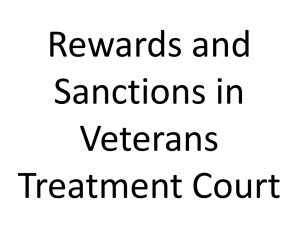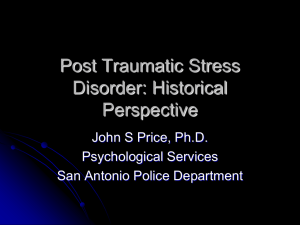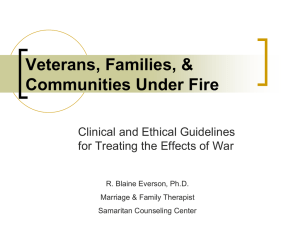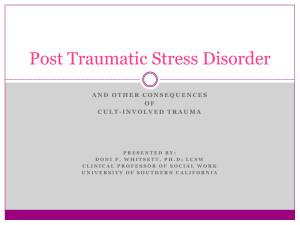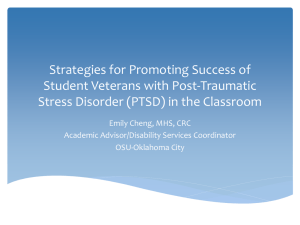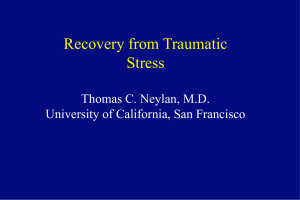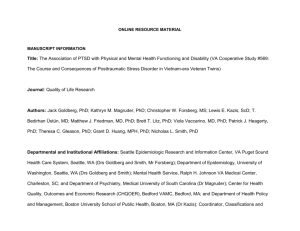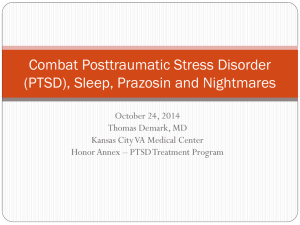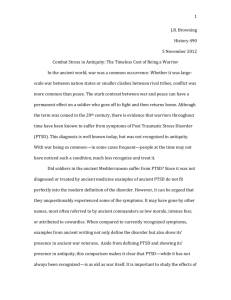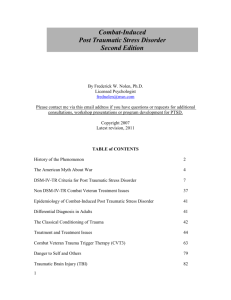Military Presentation - MI-PTE
advertisement
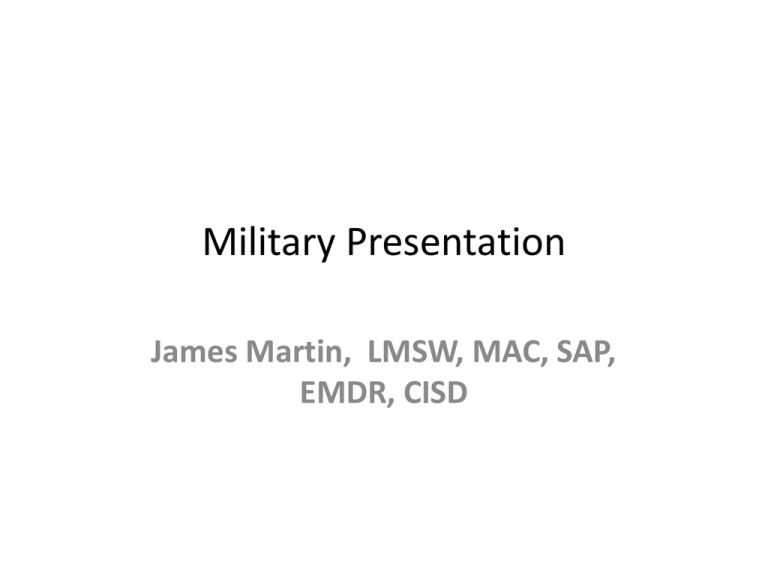
Military Presentation James Martin, LMSW, MAC, SAP, EMDR, CISD The Casualties of War • • • • • • • • History Americans at War Military Culture Deployment/Redeployment Reintegration PTSD Causes Symptoms Suicide Treatment The Veterans Commission Reported • America has 23.5 million veterans in 2007 • WWII Vets dying off • Average of 500,000 per year are dying off about 1400 per day. • By the end of 2006 Vietnam Veterans were the largest group in the veteran population. • Curently over 2 million war veterans . The Veterans Commission Reported • The effects of the current war are beginning to show • 2 million had service related disabilities at the end of 2007 and this number is rising. • The VA is not geared up to handle these numbers so vets needing help sometimes don’t receive it Who are our Military Personnel • • • • • • Active Duty 1.4 Million (48%) Reserves 1.1 million (31%) DoD Civilian Personnel 800,000 (23%) Who Are Our Military • • • • • Regular Army Regular Navy Regular Air force Regular Marines National Guard Reserves Who Are Our Military Personnel Age: • Active Duty (general) 56% are under 26 years old • Active Duty (Married) Average age 31.8 years Reserves: 40% are 36 + years old Who are our Military Personnel • • • • • • Married Active Duty : 56% Reservists : 44% Active duty with dependents: 56.8 % Reservists with dependents: 56.3% 1.2 Million dependent children of active duty service members Dual Income Families • Require Second Income 77% • Spouses of active duty personnel employed/ seeking employment 59% The Vary Nature Of Military • • • • Trained to Kill Trained to kill almost without hesitation Make life and death decisions under stress Do things that are horrible and upsetting for any human being • Their training and war experience can have a life altering impact on their lives (young) Battle Conditions • • • • • • • Fear . Guilt Extreme weather conditions, hot or cold Under constant enemy fire Extreme fatigue Perhaps four hours sleep a night Extended time Battle Conditions • • • • • One third of 10 to 21 year olds killed. Beginning 2006 weapons of choice I.E.Ds. 140,000 suffered brain injury. Almost 10,000 have accrued in 2011. June, 2011 deadliest month since 2008 - 14 attacks per day. Deployment • • • • • • Deployed Home Redeployed up to 5 times and more Reintegration Problems adjusting. Deployed again Deployment Family • • • • • • Difficulty adjusting Made decisions Finances Children (behavioral problems) Social support High rate of divorce (young) Deployed Military Personnel • • • • • Separated from family and friends Disrupted career Stress of combat Lonely, scared, angry, sad Expanded world experience and possible changes in world view Experience of Deployment Spouse at Home • • • • • • Expanded responsibilities Single parenting Handling finances Anxiety, anger, stress Loneliness Growth, change, self confidence Reintegration • Once over and leaves his/ her combat unit, those who served will inevitably rethink their experience. • That’s when they and their families will begin to experience the long term consequences of the psychological damage of the war. Reintegration • • • • • • • Home coming party or quiet time Children react in different ways to return Mixed emotions Problems connecting Life again becomes disrupted Return parent has to be updated Family has to adjust to a new normal Reintegration • Stability for the family, roles and responsibilities • Discipline now goes back to both parents • Non deployed parent may have changed • Tension and anger can increase (marital ) • Commitment to two families • Physical and psychological needs (PTSD) • CAN BE DEPLOYED AGAIN History of PTSD and TBI • • • • • History of Wars , PTSD and TBI Civil War Melancholy WW I Shell Shock WW II and Korea Combat Fatigue Vietnam War PTSD State of Denial • I don’t have a problem - I can handle it • A cultural thing , supposed to be tough • Don’t want to admit their fear so they repress it • Bond with members of unit, don’t want to leave them • Paying job don’t - want to lose it Combat-Related Stress Reactions In Denial • • • • • • Isolation from friends and loved ones Major psychiatric problems Marital and family discord Work and career problems Alcohol and drug problems Suicide PTSD • Personality Disorder, • Discharged Under Chapter 11 • 1980 Vietnam PTSD PTSD Combat Reaction to A Civilian Provocation • 1981 - 1,000 Vietnam Vets, one quarter arrested since returning home . • VA reports 150,000 or more homeless. • January, 2008 N.Y. Times investigation came up with 121 cases in which combat vets committed a killing or were charged with one after returning from war in Iraq or Afghanistan . Symptoms Of Combat PTSD and TBI Dealing With the Unseen Scars Of War • • • • Military culture - mental toughness Life time occurrence 10%-30% Currently the cases have jumped 50% Studies estimate that one in every five military returning from combat has PTSD PTSD • • • • DoD stated on the rise from 40 to 50 present PTSD is a cumulative disorder Worsens with increased exposure to combat Many troops have been deployed numerous times and their times have been involuntarily extended. • Conducting combat 10 to 12 hours per day for months on end. PTSD - I • Why PTSD REGONIZED MORE TODAY • Better medical records, • Lives saved Due to better technology Modern technology - live longer • Better medical response teams • Body armor, armored Humvees, can’t protect arms and legs, amputation increased dramatically • TBI increased from impact PTSDII • World War I and WW II – fewer that 2 soldiers wounded for each killed • Korea, Vietnam up slightly – 3 wounded for each fatality • PTSD rate in Vietnam was artificially low – little knowledge 40 yrs. Ago • Unpopular coming home, homelessness, spit on, baby killers – didn’t want attention • Counselors stated that Vietnam vets were traumatized by news media – current vets starting to seek treatment PTSDIII • More women in combat for first time in a major combat • Higher for women than men, more sensitive • Nationally there are about 1.7 million female vets, 235,000 receiving help - expect numbers to double in next 4 years • Some hit with a double whammy with sexual abuse, won’t tell due to nature of culture • Condition called personality disorder discharged under chapter 11 saved government up to 8 billion in medical benefits • Over 3,000 vets sought help in 2008 - Tri Care not accepted by some providers Suicide • Veterans Association reports seeing 18 suicides per day among 25 million veterans • DoD taking action • Reported 150,000 homeless veterans, most from the Vietnam War • Expect numbers to increase Suicide • Higher rate than any other War where records were kept • More died from suicide than military action • Rate before 9/11 - 9.1 per 1,000,000, by 2007 twice that - 24 per Per 1,000,000 • Reported that 1,000 attempts per month seen in medical facilities Suicide • First seven months of 2011 - 109 suicides • July, 2011 - suicides hit a record • Staff Sergeant shot himself to avoid his ninth deployment • A full scale crisis • Trained peers • DoD investigating Treatment Modalities • • • • • • Get solider to talk Reality Therapy Flooding Debriefing Virtual Reality EMDR Other Treatment Modalities • • • • MHN, Military One 12 sessions Mental Health on base Met plan Blue ribbon/weekendworkshops/reintegration/families/children/ Dear John 9 (letters)




